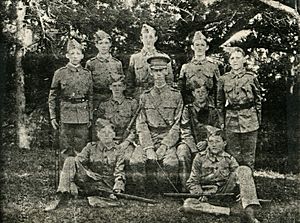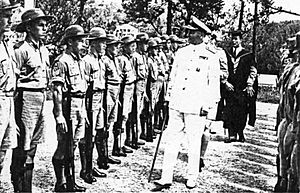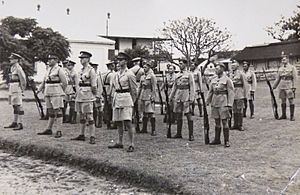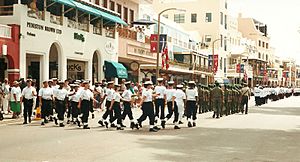Bermuda Cadet Corps facts for kids
Quick facts for kids Bermuda Cadet Corps |
|
|---|---|

Cap badge of the Bermuda Cadet Corps
|
|
| Active | 1901–2012 |
| Country | Bermuda (United Kingdom) |
| Role | Volunteer Youth Organisation British Army |
| Garrison/HQ | Bermuda Garrison |
| Commanders | |
| Ceremonial chief | Queen Elizabeth II |
The Bermuda Cadet Corps was a youth club in the British Overseas Territory of Bermuda. It was supported by the British Army and was similar to army cadet groups in England. For over 100 years, it gave young people a chance to learn military skills and discipline.
The corps was created by the Parliament of Bermuda. It was one of three cadet groups in Bermuda's history, along with the Bermuda Sea Cadet Corps and the Air Training Corps. Today, only the Sea Cadets are still active. The Bermuda Cadet Corps closed in 2012. It was replaced by the Junior Leaders program of the Royal Bermuda Regiment.
Contents
The Story of the Cadet Corps
The Bermuda Cadet Corps began in 1901 at Saltus Grammar School. It was connected to the Bermuda Volunteer Rifle Corps (BVRC), which was a local part-time army unit. The cadets often trained with the BVRC soldiers. They learned skills like shooting and marching.
In 1905, the government of Bermuda gave money to the corps so that other schools could join. This allowed more young people to become cadets. The corps was seen as a good way to encourage young men to join the BVRC when they finished school.
A Time of Change
When the Cadet Corps started, Bermuda's schools were segregated by race. This meant that only white students could join the corps. At the time, there was another part-time army unit called the Bermuda Militia Artillery that was mostly for Black soldiers.
During the Second World War (1939-1945), the Cadet Corps was very active. Many older cadets went straight into full-time military service after leaving school. In 1943, a separate cadet unit was created for Black students at The Berkeley Institute. This unit was attached to the Bermuda Militia.
After the war, in 1944, the Cadet Corps was reorganized. In the 1950s, the corps decided to start its own band. Because of the influence of officers with Scottish backgrounds, it became a pipe and drum band that wore traditional Highland dress.
A United Corps
In 1965, big changes happened in Bermuda's military. The BVRC and the Bermuda Militia Artillery joined together to form the Bermuda Regiment. At the same time, the Cadet Corps was also reorganized.
Segregation in Bermuda's public schools ended in the 1960s. After this, the Bermuda Cadet Corps opened up to students from all of the island's secondary schools. All cadets began to wear the same badge.
The pipe band, however, became a private group. It later merged with another band and is now known as the Bermuda Pipe Band. It still marches in parades with the Royal Bermuda Regiment.
To be a member of the Cadet Corps, a student had to train for two hours each week and attend a two-week camp every year.
The End of an Era
For many years, the Bermuda Regiment also ran its own youth program called the Junior Leaders. In the 1990s, the Junior Leaders program was combined with the Bermuda Cadet Corps.
However, in 2012, the Bermuda Cadet Corps was closed down due to budget cuts. The Bermuda Regiment then brought back its Junior Leaders program to take its place. In 2015, the law that created the Bermuda Cadet Corps in 1944 was officially repealed, marking the end of its long history.
Ranks in the Bermuda Cadet Corps
The Cadet Corps had ranks for both the adult instructors and the cadets themselves. The ranks were similar to those in the British Army.
Adult Instructor Ranks
| Officer Ranks | |||
| Major (Commandant) | Captain | Lieutenant | Second Lieutenant |
|---|---|---|---|
 |
 |
 |
 |
| Other Ranks | ||
| Warrant Officer Class 2 (WO2) | Colour Sergeant | Sergeant |
|---|---|---|
 |
 |
 |
Cadet Ranks
| Cadet Ranks | |||||
| Cadet Warrant Officer Class 2 (WO2) | Cadet Colour Sergeant | Cadet Sergeant | Cadet Corporal | Cadet Lance-Corporal | Cadet Private |
|---|---|---|---|---|---|
 |
 |
 |
 |
No insignia | |
Images for kids






